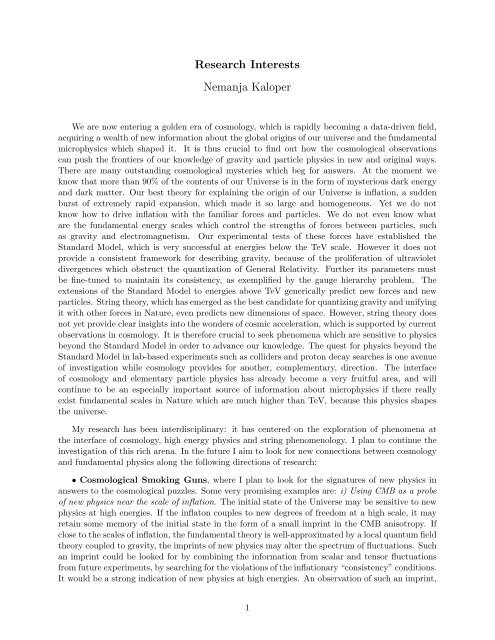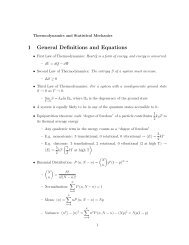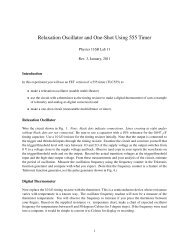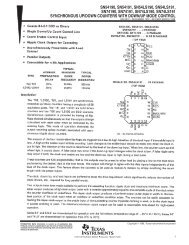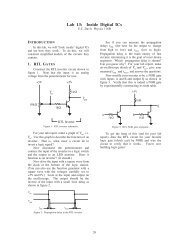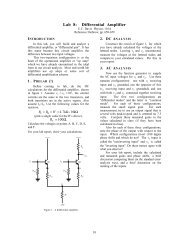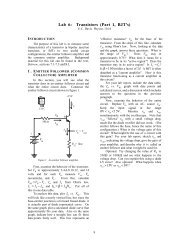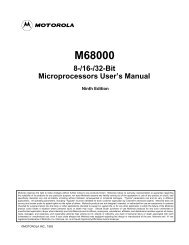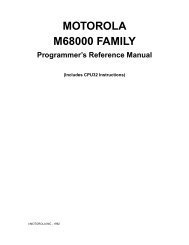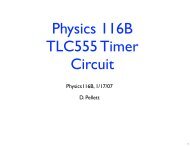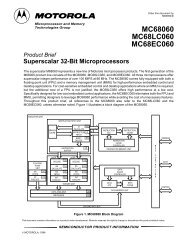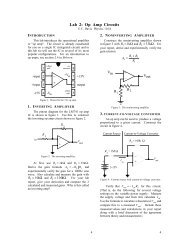Research Interests Nemanja Kaloper - Department of Physics
Research Interests Nemanja Kaloper - Department of Physics
Research Interests Nemanja Kaloper - Department of Physics
You also want an ePaper? Increase the reach of your titles
YUMPU automatically turns print PDFs into web optimized ePapers that Google loves.
<strong>Research</strong> <strong>Interests</strong><br />
<strong>Nemanja</strong> <strong>Kaloper</strong><br />
We are now entering a golden era <strong>of</strong> cosmology, which is rapidly becoming a data-driven field,<br />
acquiring a wealth <strong>of</strong> new information about the global origins <strong>of</strong> our universe and the fundamental<br />
microphysics which shaped it. It is thus crucial to find out how the cosmological observations<br />
can push the frontiers <strong>of</strong> our knowledge <strong>of</strong> gravity and particle physics in new and original ways.<br />
There are many outstanding cosmological mysteries which beg for answers. At the moment we<br />
know that more than 90% <strong>of</strong> the contents <strong>of</strong> our Universe is in the form <strong>of</strong> mysterious dark energy<br />
and dark matter. Our best theory for explaining the origin <strong>of</strong> our Universe is inflation, a sudden<br />
burst <strong>of</strong> extremely rapid expansion, which made it so large and homogeneous. Yet we do not<br />
know how to drive inflation with the familiar forces and particles. We do not even know what<br />
are the fundamental energy scales which control the strengths <strong>of</strong> forces between particles, such<br />
as gravity and electromagnetism. Our experimental tests <strong>of</strong> these forces have established the<br />
Standard Model, which is very successful at energies below the TeV scale. However it does not<br />
provide a consistent framework for describing gravity, because <strong>of</strong> the proliferation <strong>of</strong> ultraviolet<br />
divergences which obstruct the quantization <strong>of</strong> General Relativity. Further its parameters must<br />
be fine-tuned to maintain its consistency, as exemplified by the gauge hierarchy problem. The<br />
extensions <strong>of</strong> the Standard Model to energies above TeV generically predict new forces and new<br />
particles. String theory, which has emerged as the best candidate for quantizing gravity and unifying<br />
it with other forces in Nature, even predicts new dimensions <strong>of</strong> space. However, string theory does<br />
not yet provide clear insights into the wonders <strong>of</strong> cosmic acceleration, which is supported by current<br />
observations in cosmology. It is therefore crucial to seek phenomena which are sensitive to physics<br />
beyond the Standard Model in order to advance our knowledge. The quest for physics beyond the<br />
Standard Model in lab-based experiments such as colliders and proton decay searches is one avenue<br />
<strong>of</strong> investigation while cosmology provides for another, complementary, direction. The interface<br />
<strong>of</strong> cosmology and elementary particle physics has already become a very fruitful area, and will<br />
continue to be an especially important source <strong>of</strong> information about microphysics if there really<br />
exist fundamental scales in Nature which are much higher than TeV, because this physics shapes<br />
the universe.<br />
My research has been interdisciplinary: it has centered on the exploration <strong>of</strong> phenomena at<br />
the interface <strong>of</strong> cosmology, high energy physics and string phenomenology. I plan to continue the<br />
investigation <strong>of</strong> this rich arena. In the future I aim to look for new connections between cosmology<br />
and fundamental physics along the following directions <strong>of</strong> research:<br />
• Cosmological Smoking Guns, where I plan to look for the signatures <strong>of</strong> new physics in<br />
answers to the cosmological puzzles. Some very promising examples are: i) Using CMB as a probe<br />
<strong>of</strong> new physics near the scale <strong>of</strong> inflation. The initial state <strong>of</strong> the Universe may be sensitive to new<br />
physics at high energies. If the inflaton couples to new degrees <strong>of</strong> freedom at a high scale, it may<br />
retain some memory <strong>of</strong> the initial state in the form <strong>of</strong> a small imprint in the CMB anisotropy. If<br />
close to the scales <strong>of</strong> inflation, the fundamental theory is well-approximated by a local quantum field<br />
theory coupled to gravity, the imprints <strong>of</strong> new physics may alter the spectrum <strong>of</strong> fluctuations. Such<br />
an imprint could be looked for by combining the information from scalar and tensor fluctuations<br />
from future experiments, by searching for the violations <strong>of</strong> the inflationary “consistency” conditions.<br />
It would be a strong indication <strong>of</strong> new physics at high energies. An observation <strong>of</strong> such an imprint,<br />
1
in addition to signaling new physics, would strongly support the existence <strong>of</strong> the large energy desert<br />
between the Standard Model and the scale <strong>of</strong> quantum gravity. Thus the possible reward may be<br />
great: a clear-cut evidence <strong>of</strong> new physics which may be inaccessible to observation in lab-based<br />
experiments. ii) Devising new explanations for the dimming <strong>of</strong> Type Ia supernovae. At present,<br />
observations <strong>of</strong> faint supernovae are the strongest evidence for cosmic acceleration. However if<br />
only a fraction <strong>of</strong> the photons departing supernovae reach us, the supernovae would appear fainter<br />
without cosmic acceleration. I have proposed such an explanation recently, invoking an axion-like<br />
particle with couplings to the photon. In the presence <strong>of</strong> extra-galactic magnetic fields, <strong>of</strong> order<br />
nano-Gauss, coherent over Mpc-sized domains, a photon can turn into an axion evading detection<br />
on the Earth. A supernova would then appear fainter even if the Universe is decelerating. This<br />
changes quite dramatically the nature <strong>of</strong> dark energy, avoiding the cosmological event horizon. The<br />
axion could also provide a source <strong>of</strong> ultrahigh-energy cosmic rays. Finally, some recent analysis<br />
indicate that the Universe may be expanding even faster than allowed with normal dark energy,<br />
suggesting the interpretation in terms <strong>of</strong> the so-called “phantom” field, which is a ghost with illdefined<br />
Hamiltonian that is not bounded from below. It would lead to a future Big Rip singularity.<br />
In theories with the axion, this can be more naturally explained without any “phantoms”, simply<br />
as a combined dimming effect coming from both the non-singular dark energy and the conversion<br />
<strong>of</strong> photons into axions. iii) Explaining the unknown origin <strong>of</strong> the extra-galactic magnetic fields<br />
by combining inflation with the dynamics <strong>of</strong> extra dimensions. Inflationary perturbations could<br />
squeeze the magnetic field into coherent states, which can be amplified by the extra-dimensional<br />
dynamics. In models where the extra dimensions are initially small, inflation is followed by an epoch<br />
<strong>of</strong> expansion <strong>of</strong> extra dimensions, during which the four-dimensional world shrinks, enhancing the<br />
primordial magnetic fields. This may provide a new window into the extra-dimensional physics.<br />
• High Energy Frontiers, where I intend to pursue new ideas in high energy physics as<br />
a method <strong>of</strong> solving cosmological problems. Among the aims are: i) Developing new models <strong>of</strong><br />
inflation. While inflation is the best framework for explaining the origin <strong>of</strong> the Universe, it is still<br />
unclear how it should be implemented in fundamental theory. Inflation requires the existence <strong>of</strong><br />
light degrees <strong>of</strong> freedom with very flat potentials and positive vacuum energy, which are hard to<br />
obtain from first principles. A new direction to pursue is to incorporate inflation in new models<br />
with non-minimal couplings to gravity and matter, such as brane-motivated constructions where<br />
moduli can be inflatons. ii) Exploring modifications <strong>of</strong> gravity to attack the cosmological constant<br />
problem. Cosmological constant problem is presently the greatest <strong>of</strong> all the unsolved problems in<br />
fundamental physics. Our best estimates <strong>of</strong> the cosmological vacuum energy density overshoot the<br />
observational bounds by at least 60 orders <strong>of</strong> magnitude. This clearly shows that our understanding<br />
<strong>of</strong> effective field theory coupled to gravity at very large scales is incomplete. A possible way around<br />
the cosmological constant problem, which I plan to pursue, is to modify gravity in the far infrared.<br />
This may account for the small cosmological acceleration by a weakening <strong>of</strong> the gravitational<br />
impact <strong>of</strong> a very homogeneous distribution <strong>of</strong> energy in the Universe. A model <strong>of</strong> this type has<br />
been proposed by Arkani-Hamed, Dvali, Dimopoulos and Gabadadze. However in its original form<br />
this interesting model is not consistent with the usual general covariance. This malady can be cured<br />
by additional modifications which involve higher powers <strong>of</strong> curvature and restore the symmetry <strong>of</strong><br />
the model. It remains to determine the full series <strong>of</strong> such terms through an iterative procedure,<br />
which I am currently developing. Once this is in place, the consequences <strong>of</strong> modifications <strong>of</strong> gravity<br />
at large distances can be explored in detail.<br />
• Holography and Formal Theory, where I am planning to continue to search for the implications<br />
<strong>of</strong> holography for low energy physics. At the moment, I am planning to pursue the following<br />
two directions: i) Holography and cosmological initial conditions. A remaining conundrum in the<br />
2
early universe cosmology is the problem <strong>of</strong> initial conditions. It seems to require the formulation <strong>of</strong><br />
a complete theory <strong>of</strong> quantum gravity, which is still lacking. Currently string theory is the forerunner<br />
for the quantum theory <strong>of</strong> gravity unified with other forces, and so it is natural to hope that it<br />
may give new insights into the problem <strong>of</strong> initial conditions, and the origin <strong>of</strong> inflation. However at<br />
present we are only beginning the search for interesting cosmological backgrounds which are under<br />
control in string theory. In the absence <strong>of</strong> a precise formulation <strong>of</strong> string cosmology, it may be<br />
helpful to look for guidance from some <strong>of</strong> the principles believed to govern it, and this guidance<br />
may be provided by holography. The principle <strong>of</strong> holography posits that quantum gravity must<br />
respect unitarity. In cosmological applications, the holographic principle and the existence <strong>of</strong> the<br />
limit where the theory reduces to Einstein gravity point to the following properties <strong>of</strong> quantum<br />
gravity: 1) for systems whose total entropy approaches the covariant entropy bounds, the description<br />
based on the volume-distributed oscillator modes breaks down, and should be supplanted by<br />
the dual “screen” theory; and 2) at energies well below the Planck scale where the system is dilute<br />
enough, quantum gravity should quickly reduce to the description in terms a quantum field<br />
theory weakly coupled to Einstein’s gravity. This suggests that a gravitating system has far fewer<br />
degrees <strong>of</strong> freedom than naively expected, which means there are fewer consistent initial conditions<br />
for gravity. Hence holography may help pick the initial conditions <strong>of</strong> the Universe, and develop<br />
a model where inflation naturally starts as the holographic phase ends. A successful model with<br />
this kind <strong>of</strong> behavior could simultaneously solve the problem <strong>of</strong> initial conditions for inflation and<br />
produce imprints <strong>of</strong> the holographic phase in density perturbations. ii) Search for the bulk duals<br />
<strong>of</strong> Hawking radiation. Here I aim to continue the investigation <strong>of</strong> the connection between classical<br />
brane-localized black holes and quantum-corrected black holes in CFT+gravity theory, which I<br />
have proposed recently. One interesting possibility is to study what happens when black holes are<br />
charged by both brane-localized and bulk charges, because in the dual CFT+gravity theory these<br />
objects should correspond to configurations with or without dilatonic secondary hair, respectively.<br />
The consideration <strong>of</strong> such black holes, which are relatively simple objects thanks to the bulk dynamics,<br />
may shed light on the structure <strong>of</strong> cross-couplings between the CFT and brane-localized<br />
matter fields.<br />
These directions <strong>of</strong> research are very promising because they are synergistic at a very fundamental<br />
level, being firmly based on the intricate connection between cosmology and particle physics.<br />
This <strong>of</strong>fers new opportunities for the searches for new phenomena, which is crucial at the time when<br />
cosmology is becoming a unique testing ground for fundamental physics beyond the TeV frontier.<br />
3


